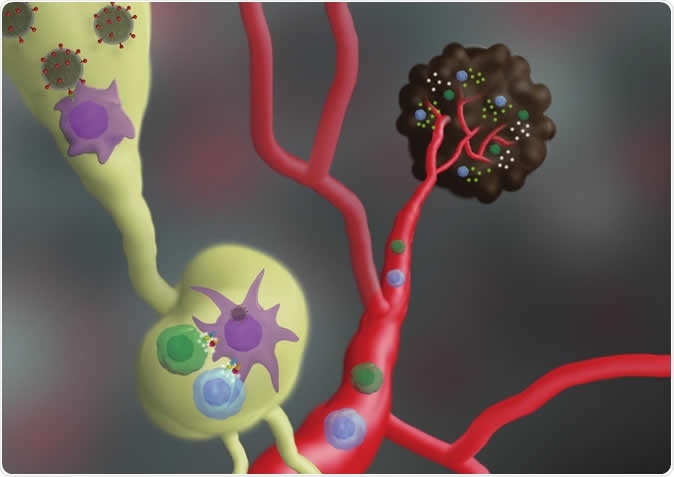A new study has shown that fat cells could be implicated in the transformation of the melanoma cells in the skin into highly malignant cells that spread to the different organs of the body. A team from the Tel Aviv University, led by Prof. Carmit Levy and Dr. Tamar Golan of the Department of Human Genetics and Biochemistry at TAU's Sackler School of Medicine published their findings in the journal Science Signaling this week.

Nano-vaccine mechanism of action: following injection, the nano-vaccine internalizes into immune cells, leading to activation of T cells to recognize and attack melanoma. Image Credit: Professor Carmit Levy/AFTAU
Their study was titled, “Adipocytes sensitize melanoma cells to environmental TGF-β cues by repressing the expression of miR-211.” Other researchers on the team were Dr. Hanan Vaknin of Wolfson Medical Center, and Dr. Dov Hershkowitz and Dr. Valentina Zemer of Tel Aviv Medical Center.
Prof. Levy said about their study, “We have answered a major question that has preoccupied scientists for years.” She explained that a skin change or a melanoma is usually trapped within the outer layer of the skin called the epidermis. At this stage it can be removed and has no risk of spreading. She added, “What makes melanoma change form, turning aggressive and violent? Locked in the skin's outer layer, the epidermis, melanoma is very treatable; it is still Stage 1, it has not penetrated the dermis to spread through blood vessels to other parts of the body and it can simply be removed without further damage. Melanoma turns fatal when it 'wakes up,' sending cancer cells to the dermis layer of skin, below the epidermis, and metastasizing in vital organs. Blocking the transformation of melanoma is one of the primary targets of cancer research today, and we now know fat cells are involved in this change.”
For this study the team of researchers including pathologists collected biopsy samples from the melanoma patients who visited the Wolfson Medical Center and Tel Aviv Medical Center. Under the microscope they noted that there was an abundance of fat cells near the melanoma sites. Professor Levy added, “We asked ourselves what fat cells were doing there and began to investigate. We placed the fat cells on a petri dish near melanoma cells and followed the interactions between them.” This process of putting the melanoma cells with the fat cells was called a “coculture”. They noted that within the petri dish the fat cells started transferring certain proteins to the melanoma cells. These proteins were identified as cytokines that could help genetic transformations in the melanoma cells that made them more aggressive. The authors wrote, “Transforming growth factor–β (TGF-β) superfamily members are critical signals in tissue homeostasis and pathogenesis”. They added that the progression of melanoma depends on, “increased sensitivity to microenvironmental TGF-β.”
Levy explained the results saying, “Our experiments have shown that the main effect of cytokines is to reduce the expression of a gene called miRNA211, which inhibits the expression of a melanoma receptor of TGF beta, a protein that is always present in the skin. The tumor absorbs a high concentration of TGF beta, which stimulates melanoma cells and renders them aggressive.” They noted, “In a coculture system, adipocytes secreted the cytokines IL-6 and TNF-α, which induced a proliferative-to-invasive phenotypic switch in melanoma cells by repressing the expression of the microRNA miR-211.”
As the next step the team tried to block this transformation. “It is important to note that we found the process reversible in the laboratory: When we removed the fat cells from the melanoma, the cancer cells calmed down and stopped migrating,” said Professor Levy. In mice models they repressed the genes coding for miRNA211. This caused the melanomas to become aggressive and attack other organs. Once these genes were allowed to express the miRNA211 again, the risk of the melanoma becoming aggressive and spreading to other organs fell drastically.
The team explains that they tried therapies which could inhibit cytokines and TGF beta. Dr. Golan explained, “We are talking about substances that are currently being studied as possible treatments for pancreatic cancer, and are also in clinical trials for prostate, breast, ovarian and bladder cancers. We saw that they restrained the metastatic process, and that the melanoma returned to its relatively 'calm' and dormant state.” Prof. Levy added, “Our findings can serve as a basis for the development of new drugs to halt the spread of melanoma -- therapies that already exist, but were never used for this purpose. In the future, we are seeking to collaborate with drug companies to enhance the development of the metastatic melanoma prevention approach.”
Journal reference:
Adipocytes sensitize melanoma cells to environmental TGF-β cues by repressing the expression of miR-211, Tamar Golan, Roma Parikh, Etai Jacob, Hananya Vaknine, Valentina Zemser-Werner, Dov Hershkovitz, Hagar Malcov, Stav Leibou, Hadar Reichman, Danna Sheinboi, Ruth Percik, Sarah Amar, Ronen Brenner, Shoshana Greenberger, Andrew Kung, Mehdi Khaled, and Carmit Levy, https://stke.sciencemag.org/content/12/591/eaav6847